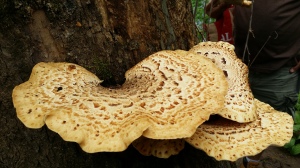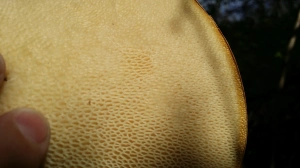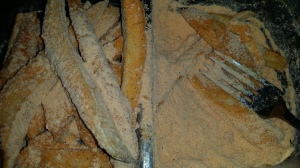Remember, never eat anything you are not 100% sure of. I take no responsibility for what happens to you if you eat something you incorrectly identify.
The spring has finally sprung. It was a difficult winter; the South and West was unusually mild, and dry while the Midwest and East got pounded with bitter cold and snow. Spring arrived with warm to hot days and frigid night and late snow overnight in my part of the Midwest. While the weather is still a little erratic, but it is getting warmer than it is staying colder.
All of the winter snow and early rains has meant a veritable explosion of wild flowers in my area. It is also causing what some have said will be the best morel mushroom season in recorded history. I think that is an awfully bold statement, but it is indeed looking to be a good year for them. It also, as it turns out, turning out to be a bumper crop year for another edible fungus, the “Dryad Saddle” or the “Pheasant’s Back” which is more correctly known as Polyporus squamosus. It is a pretty distinctive mushroom that smells (and according to many tastes) like a watermelon rind.
 Squamosus can get to be really substantially large. I have seen them over a foot across. They are pretty much inedible at that size, but very pretty to look at. The smaller specimens, provided that they are tender and flexible, are more ideal to eat.
Squamosus can get to be really substantially large. I have seen them over a foot across. They are pretty much inedible at that size, but very pretty to look at. The smaller specimens, provided that they are tender and flexible, are more ideal to eat.
The key elements to identifying P. Squamosa are that it is almost always growing on dead wood. If it is on living wood… that tree is in serious trouble and the Dryad knows it. They have a short stalk, and can be alone or in associated brackets. The top of the mushroom is a tan, or butter yellow with darker scales. This feature is the one that earned it the colloquial name “Pheasant’s back” because it looks a bit like feathers.
 The underside of the mushroom is comprised of very small pores. Polyporus literally means “many pores.” If you find a mushroom growing on a tree that has gills, it isn’t a P. Squamosus.
The underside of the mushroom is comprised of very small pores. Polyporus literally means “many pores.” If you find a mushroom growing on a tree that has gills, it isn’t a P. Squamosus.
The single most distinctive feature of this fungus after appearance is its fragrance. P. squamosus smells like watermelon rinds. Some people say cucumber, but I find watermelon to be more accurate in my experience.
I think it is that very fragrance and people’s tendency to take the largest version of anything they get to be the reason this delightful mushroom is so over looked as an edible. First, the smaller the better. I try to take ones that I am fairly confident have spored, so I avoid the little nubby baby dryads. I try to get them when they are still tender but have had a chance to reproduce. If it cuts like a knife through hot butter, you are there.
This was the results of a few hours walk with the Missouri Mycological Society in Washington State Park this last Sunday. There are Morchella semilibera, Morchella diminutiva, and Polyporus squamosus. In plain English, that is the half free morel, tiny morels (to my knowledge there isn’t a colloquial name for the diminutiva morel. Someone correct me if I am wrong) and the Dryad’s saddles or Pheasant Backs. 
Now I have a confession to make; I hate potatoes. I know, I know, I’m a monster. They just.. ick. I can’t really stand fries. My kids love fries. I hate them.
Soooooo… the good news is that Dryad Saddles make EXCELLENT fries. If they are young, and tender, you can slice them thinly, bread, fry them (I use olive oil so I can pretend the health benefits of olive oil counter the effect of frying) and eat them with your burgers. Other than the calories added by breading and frying, mushrooms are pretty close to zero. 
If you get really small ones, they look like mustaches when you slice across them. If you have a kid who is mustache crazy like one of mine is… it makes for a happy and amusing dinner.
The breading is made from a mix of flour and corn meal (finely ground) with salt, pepper, dried garlic and onion powder. Maybe some turmeric for color. I know many people who use the Andy’s vegetable breading, but it has dried peppers (as in paprika) and I have an allergy to peppers (yes, all peppers, but not black pepper. Black pepper is a seed from a tree, Piper nigrum. I mean anything in the Capsicum genus; it is the capsicum specifically that I am allergic to). IF you don’t want to make your own breading, you CAN just use a mild commercial version.
 First, you soak the mushrooms in a mix of beer and water. I know several mushroom enthusiasts who are now freaking out. They don’t like to hear the words “soak” and “mushroom” in close proximity. So I say to them “blah blah blah.” I know what can live in mushrooms, so I soak them. You don’t have to. The beer helps break the surface tension that allows all the little things to live on mushrooms to float away. It also adds a bit of flavor. The alcohol cooks out of it. That happened to be the beer I had handy, so that is what I used.
First, you soak the mushrooms in a mix of beer and water. I know several mushroom enthusiasts who are now freaking out. They don’t like to hear the words “soak” and “mushroom” in close proximity. So I say to them “blah blah blah.” I know what can live in mushrooms, so I soak them. You don’t have to. The beer helps break the surface tension that allows all the little things to live on mushrooms to float away. It also adds a bit of flavor. The alcohol cooks out of it. That happened to be the beer I had handy, so that is what I used.
Next, I slice them really thin; make sure that it is sliced thin so that it cooks through by the time the breading has browned. 
Make sure that they are really well coated with breading. The oil should be at about 335 degrees, and it really doesn’t matter what kind of oil you use, though I urge you to use a good quality one. I use an obnoxiously expensive olive oil, which does impart a mild flavor, but not too much of one. I mostly do it so that I can pretend the health benefits of olive oil offset the whole frying thing. The lies we tell ourselves.
I plan to experiment with Dryad’s a little more. I am going ot try to shred some and turn it into meatballs or burgers. Might be amazing. Might be worse than flaming dog food. Only time and experimentation will tell.
The breading mix works really great with onions, too. When I run out of mushrooms and still have breading, we pull out the onions. Sometimes it is onion rings, sometimes we do blooming onions, and every once in a while I make what we call “burger onions.” That is where I slice the burger horizontally and rather than separate the rings, I bread the whole slice and then fry it. Tastes great on burgers. They key is using sweet onions. Vidalia or the Sweet Mayans.
 YUM!!! So many people pass on these mushrooms, or worse, harvest and not eat. Get them small, ignore the smell and give them a chance and you will see how wonderful they really are!
YUM!!! So many people pass on these mushrooms, or worse, harvest and not eat. Get them small, ignore the smell and give them a chance and you will see how wonderful they really are!

Thank you so much for posting this! My mother & I have harvested morels for years and I ran across a few of these a week ago and got them my mother wasn’t interested in something she never heard of so I looked on here to make sure that’s what they were and they are Dryads Saddle so we found some more,I soaked them and we always fry our morels in cornmeal and fry them in a pan after we’ve soaked the so I’ve soaked these and came across what you wrote I was looking to see if I could fry them in cornmeal and that us what I’m going to do today,so thank you so much for your post and information! 🙂
LikeLike
Um-mm I love morels one of my favorites! I’ve never tried pheasant’s back sounds good though.
LikeLike